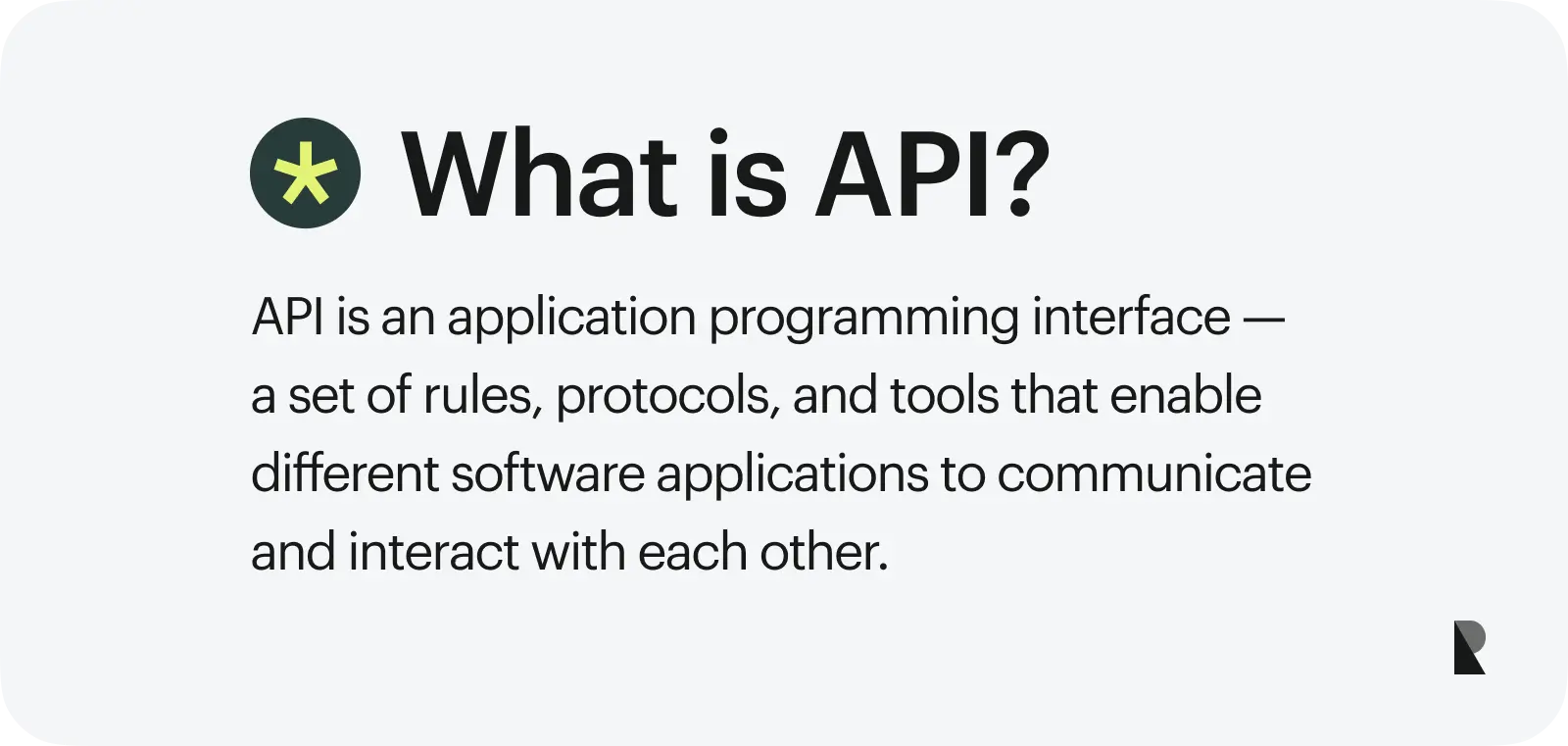
You may have heard of an API or the acronym API. You may have seen technical folks talking about APIs in sites they produce, but these conversations often fail to cater to you, the end-user. I'd love to tell you all about this mysterious thing called an "API". It's a way to launch common actions throughout different applications, typically including text, image, video, and possibly audio content.
APIs often allow third-party services to connect seamlessly with websites, mobile apps, and devices. The API lets them do things like post content on your site or send messages. This article, however, is not that kind of guide. Instead, I'll try to explain what an API actually is and why it might be useful for you or your company.
You know that it's essential to create APIs to allow third parties to run code on your site. This is because APIs are core components of many websites and apps, making them pretty important for each professional web app development team. You can also use this technology to connect with other systems and popular cloud platforms such as Google Cloud, AWS, and Azure.
The benefit you get from using APIs over regular services is making your development process simpler as well as making it easier for others.
An API is a piece of software that allows other software to interact with it. It's akin to the documentation in traditional applications, which you might use to help find things like features and utilities. A web API is an application that offers a set of functions using HTTP protocol along with a programming language such as Java, C#, PowerShell, or Python.
API Definition
This helps reduce the complexity of developing apps and websites using APIs. APIs can be assumed to be like lego blocks. Similar to Lego blocks, you can use several APIs to build a product rather than starting from scratch.
Types of APIs
APIs are classified into four types:
1. Open APIs
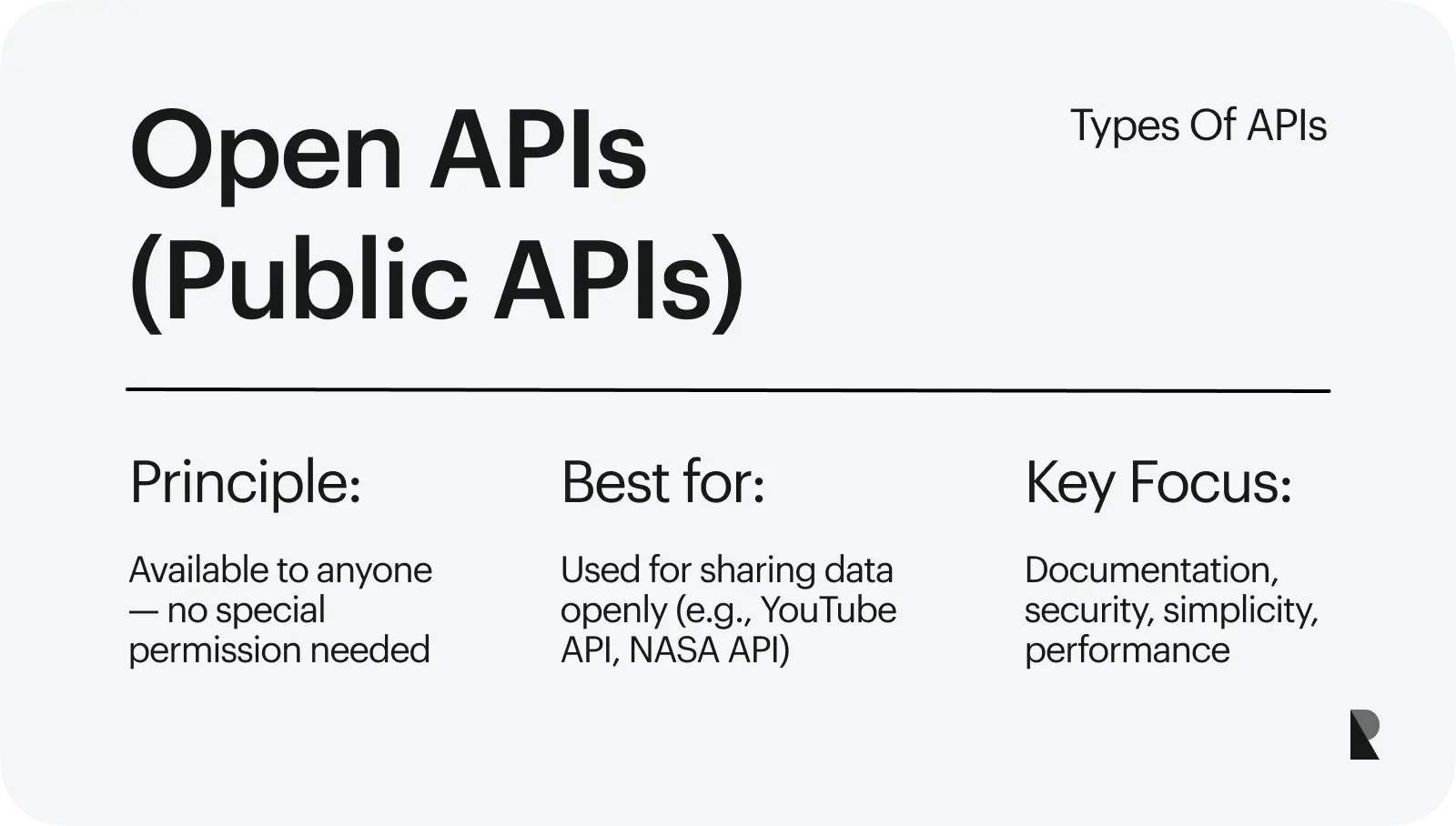
Open APIs are also called Public APIs. Open APIs are available for public use. This means anyone can build products and services with those APIs without explicit permission or authentication with an API key or simple authentication. There are thousands of Open APIs available on the internet for you to use in your products. The OpenAPI Specification is a format for defining the structure and syntax of REST APIs. Because OpenAPI documentation is both machine and human-readable, anyone can simply identify how each application programming interface works. APIs can be used by engineers to plan and construct servers, create code, and implement contract testing. Other internal teams can use these API specifications to identify the footprint and dependencies of their API program. YouTube API, NASA API, and Twitter API are a few examples of popular open APIs.
Making APIs public has various benefits, the most important of which is the ability to freely share data. Third parties can immediately exploit the data provided by the open API due to its lack of constraints and ease of deployment. This invites any external business or developer to interface with the app that owns the API, increasing the value of both the third-party product and the API. Developers working on APIs should keep the following in mind: open APIs should have strong documentation, security, simplicity, and performance.
2. Internal APIs
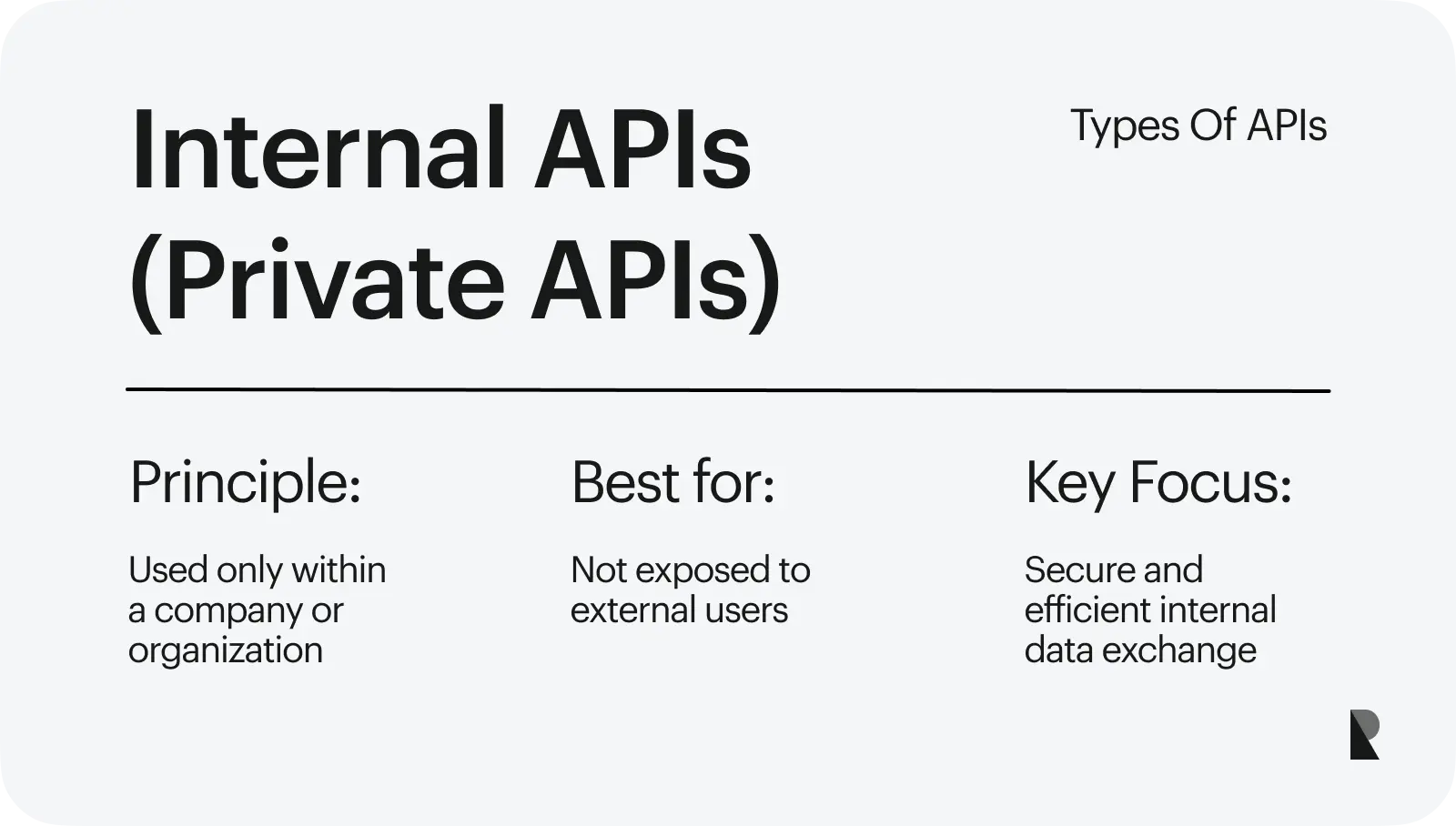
Internal APIs are also known as Private APIs. These APIs are only available to internal apps and are not exposed to the general public. Every company creates its own internal APIs for a variety of reasons, including reusing components, making it easier to construct apps on top of other applications, and so on. APIs are thought to be more efficient, secure, and transparent for internal data exchanges. Internal APIs can be used by companies to scale solutions These types of APIs are restricted to a company or application.
3. Partner APIs
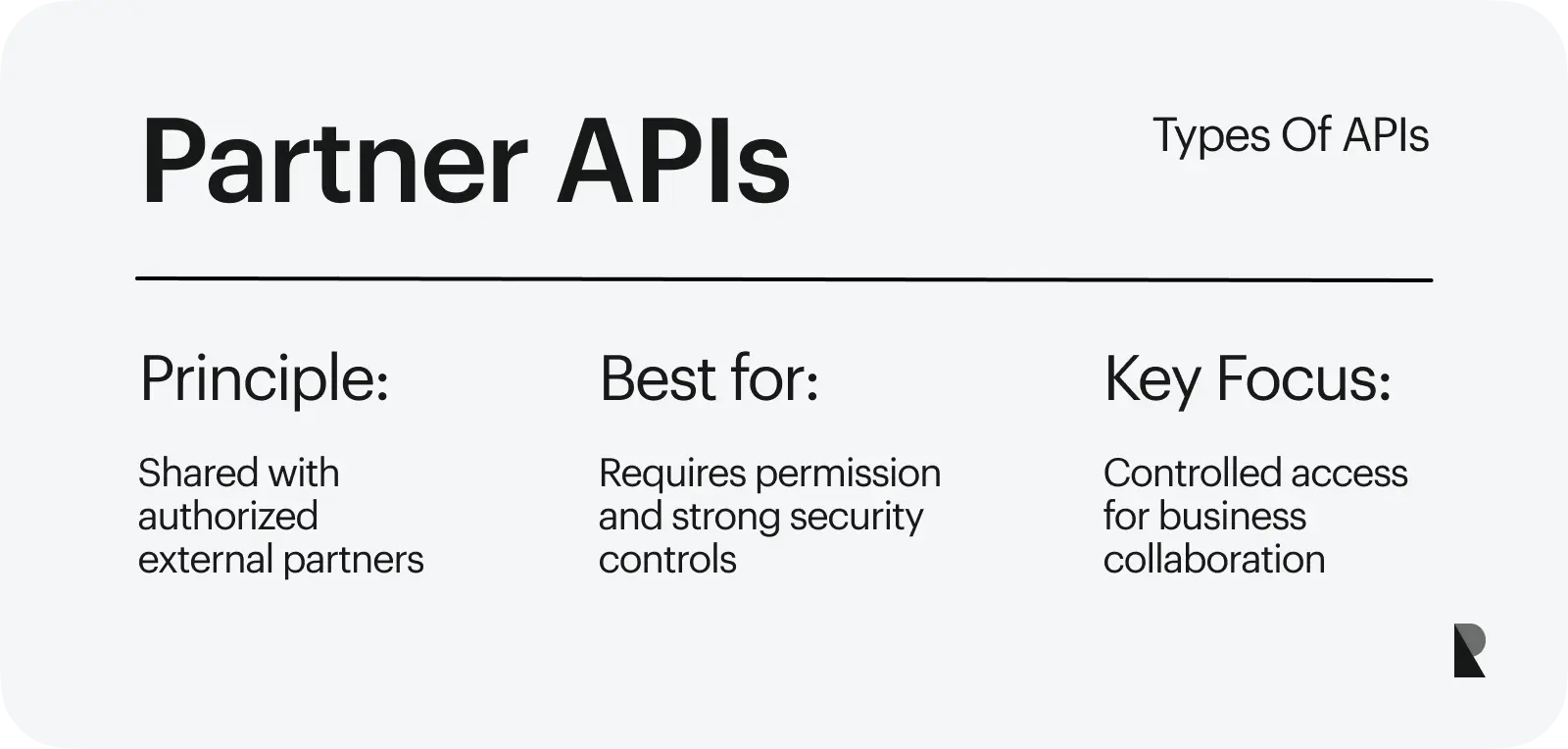
These APIs are licensed and can only be used with the API provider's permission and authorization. These APIs are frequently shared across firms with which they have business partnerships. Unlike open APIs, here APIs must have significant security and performance safeguards.
4. Composite APIs
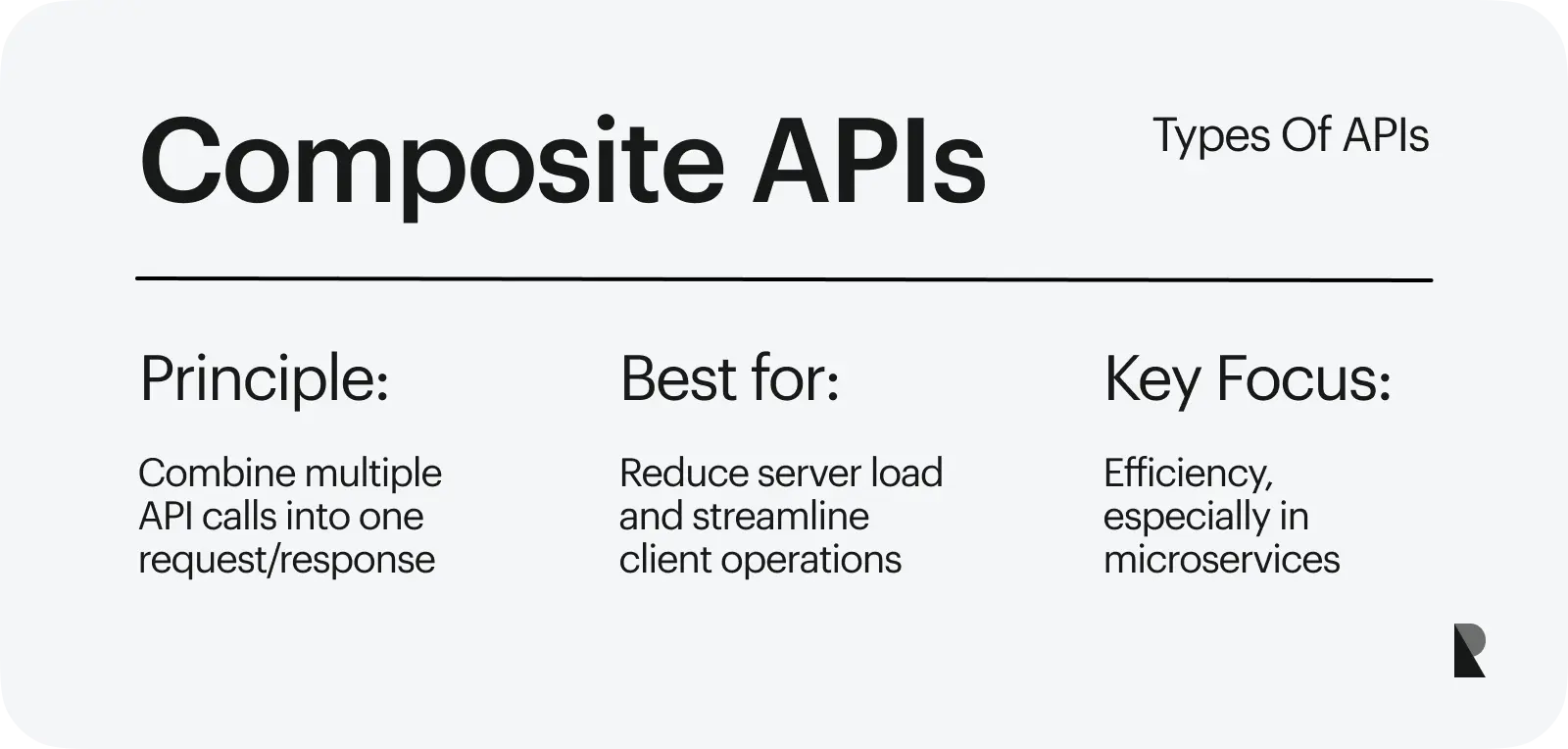
Composite API is a design strategy that combines multiple API calls into a single API call. Rather than making several queries, the client can make multiple requests once and receive a single response. This strategy allows for a reduction in server load. Developers do not need to create a new API for this; instead, they can mix existing API requests to create a composite API. These are frequently used in microservices, where one job may require data from multiple internal APIs to complete.
The OpenAPI Specification is a format for defining the structure and syntax of REST API. API specifications are both machine and human-readable, anyone can simply identify how each API works. Making APIs public has various benefits, the most important of which is the ability to freely share data. This invites any external business or developer to interface with the app that owns the API. Every company creates its own internal APIs for a variety of reasons.
These include reusing components, making it easier to construct apps on top of other applications, and so on. Unlike open APIs, here application programming interfaces must have significant security and performance safeguards. Composite API is a design strategy that combines multiple API calls into a single API call.
Types of API formats
Many developers are likely familiar with the four types of API formats: REST, SOAP, GraphQL, and gRPC. And while they may be familiar, it's likely that some developers still don't know what the benefits of each format truly are. So let's break this down by looking at exactly what these four types are - and how each stands out from another when it comes to abstraction and access.
When it comes to APIs, you must choose a web API that best meets your requirements. It might be REST, SOAP, GraphQL, or gRPC. Each of these formats enables you to transport data at up to ten times the speed of HTTP. Each has advantages and disadvantages.
1. REST
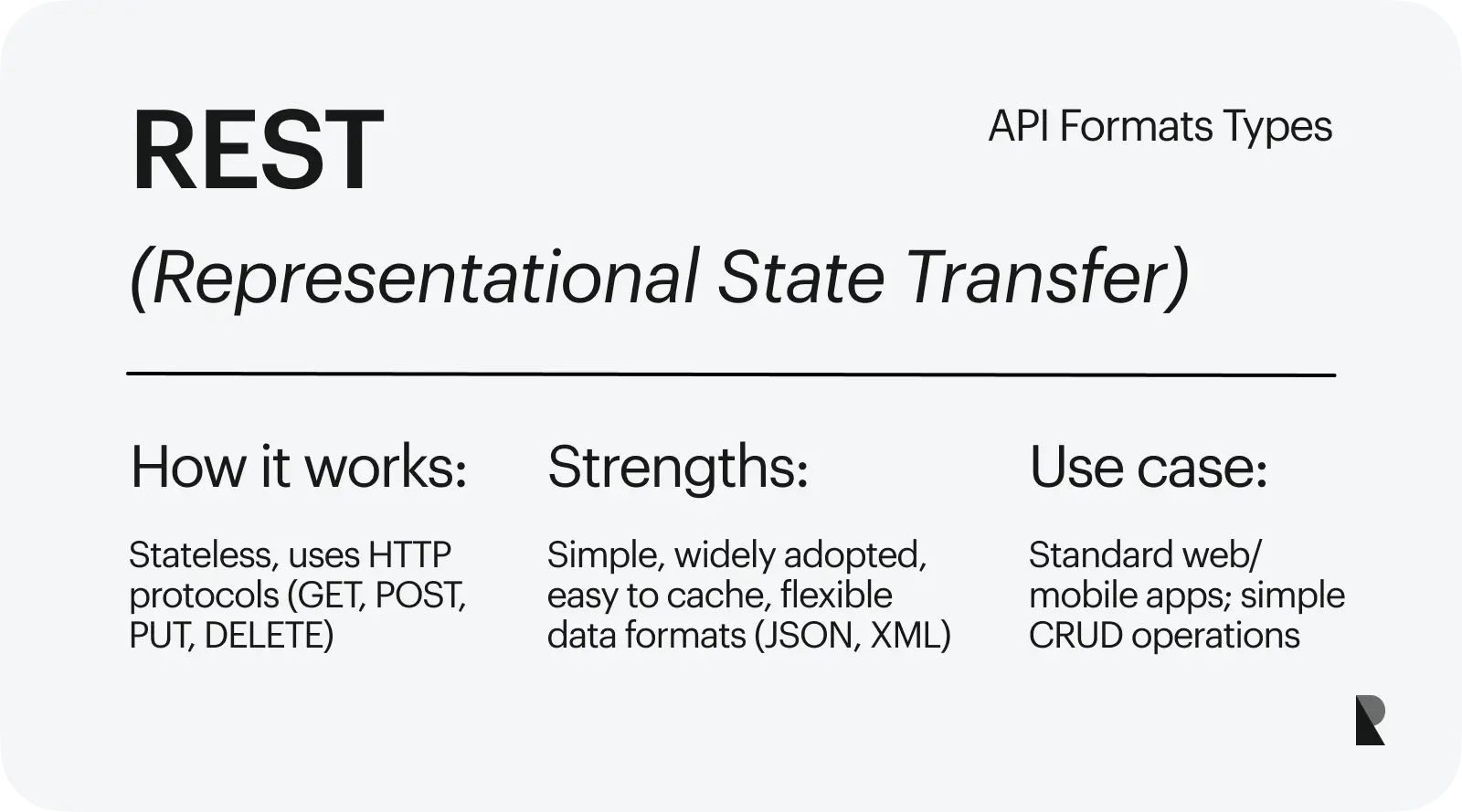
What is REST API? A question we've all been asked at one point or another, even if we don't know what it means. REST stands for Representational State Transfer and is an API framework for creating applications that are stateless, i.e. the application doesn't keep track of the number of requests it has processed or anything like that. REST uses HTTP 1.1 protocol to exchange data. It's the opposite of SOAP, a protocol that makes use of XML-based messages to transfer data between clients and servers.
For example, imagine you are building a tool to order food from your favorite restaurant and want to develop a restful web API that lets people order food through their website or mobile app. You would create a separate server-side script (in this case expressjs) and register an endpoint there:
GET https://example.com/order?user_id=6t5363&food_type=full&amount=3What you'd get back would be:
{ "status": "0', "message": "Successfully processed order!", "message_type": "invoice", "amount": 3} What seems really strange at first glance is that there's no mention of user-id, food type, and number – because they aren't needed when using the API.
Many developers are concerned with building the right REST API nowadays.
2. GraphQL
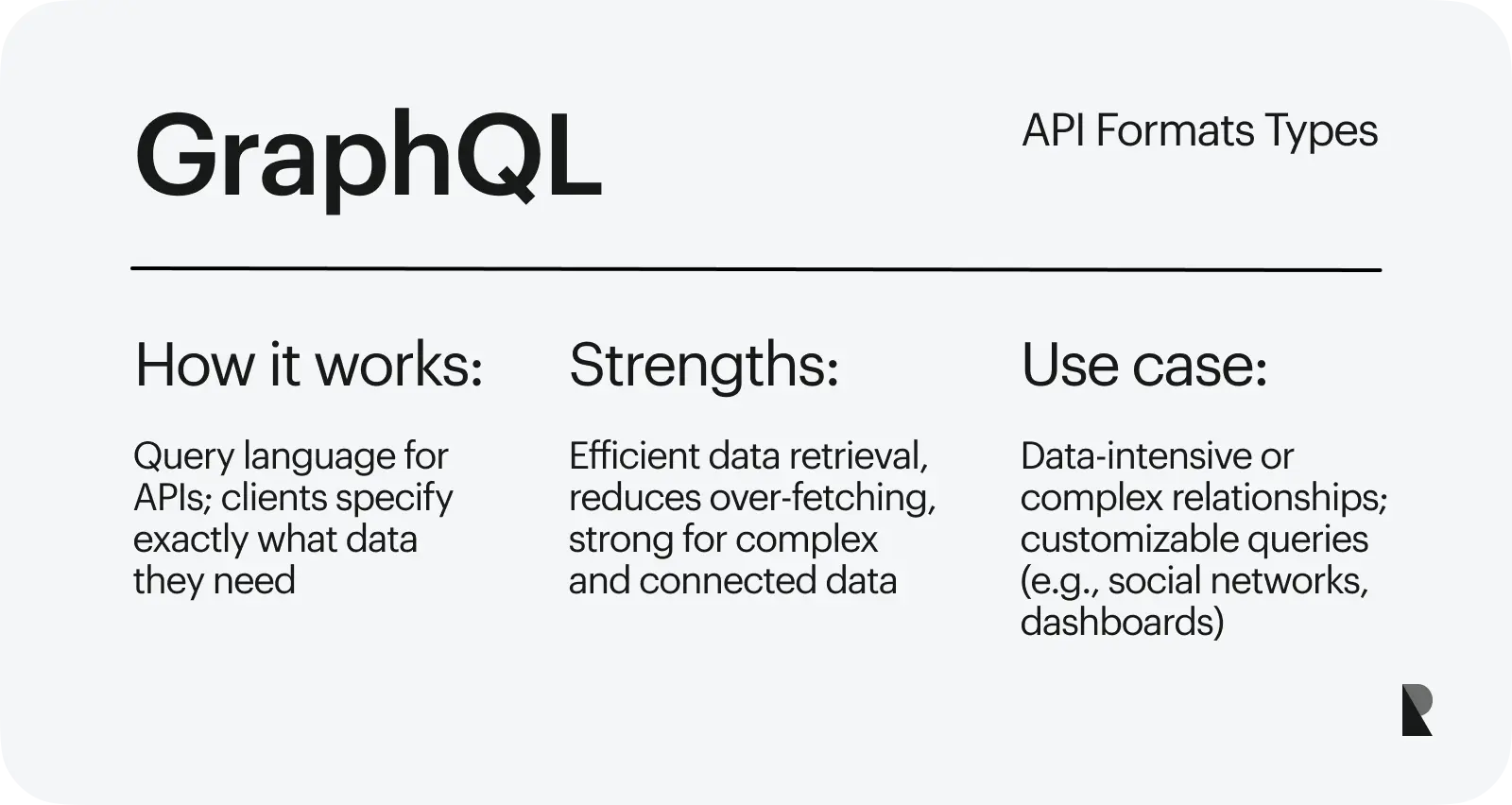
GraphQL is a query language for APIs. It was created by Facebook to help its own internal software, but since then it has become increasingly popular and gained traction among other companies offering a wide range of services on the internet. GraphQL enables you to develop an interface that allows applications to make queries that describe how they want data to be retrieved.
One of the most popular alternatives to a relational database is a graph database. Graphs are much more flexible than traditional database tables because they directly map to real-world entities and the relationships between them. This makes graph-based systems a natural choice for modeling data that is highly connected and hierarchical, such as the people, places, or things involved in social networks.
In GraphQL, we get exactly what we want. This increases efficiency and simplifies data-intensive applications. But, via REST, we must retrieve all of the data even if we only want one data column. As a result, we can conclude that graphql provides more control over specifying the structure of a request and response data.
See the GraphQL query below to retrieve the top three posts sorted by date. We can explicitly indicate what data we wish to receive here.
query GetPosts { posts(orderBy: createdAt_DESC, first: 3) { coverImage excerpt publishedAt slug title content }}3. SOAP
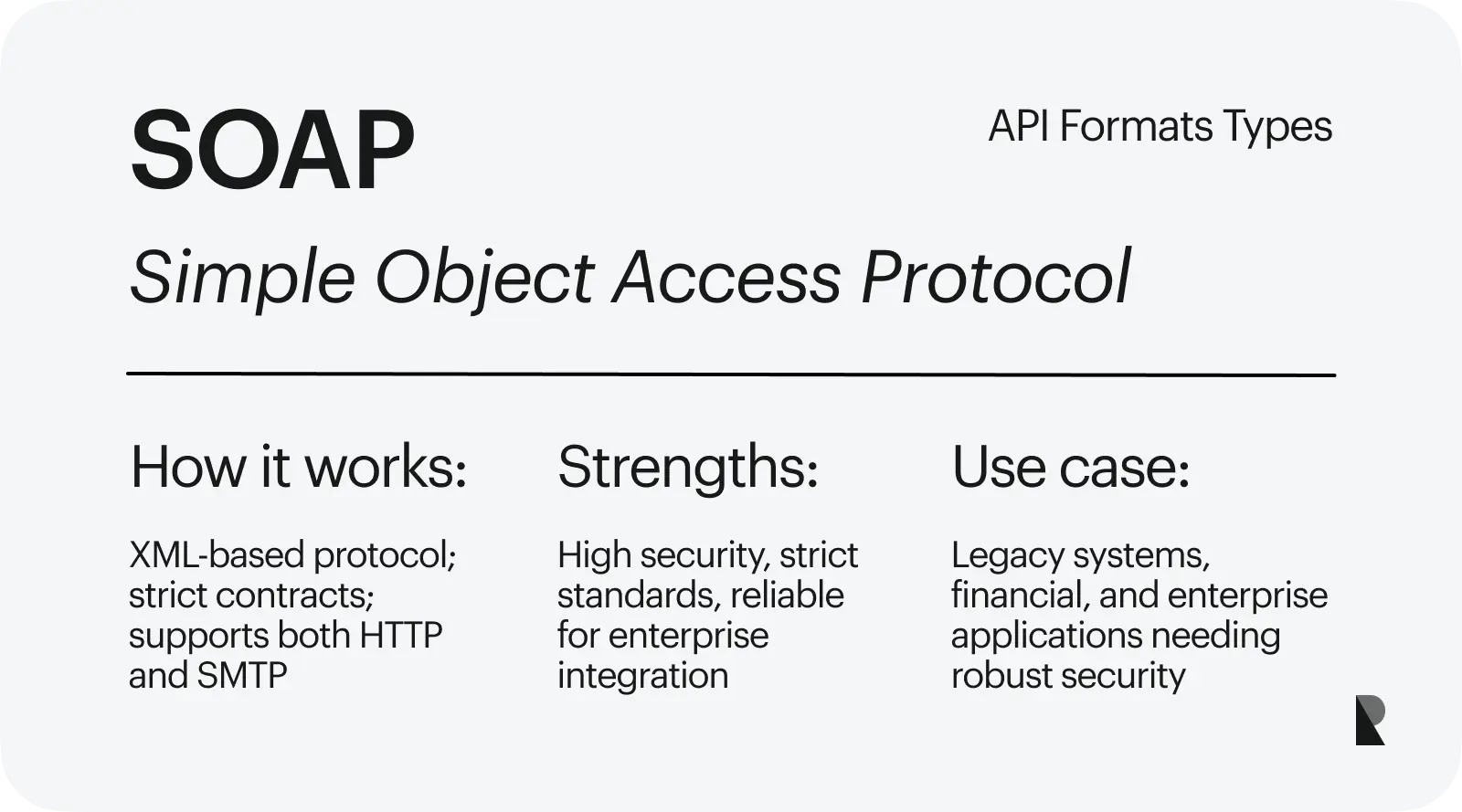
Over the years, applications have evolved to include new features and services. The introduction of SOAP API in a Microsoft Office 365 environment is one of these major changes. But what exactly is SOAP API? And why should you stay away from it?
Soap API is an open standard for web services. It is a simple way of accessing data from web applications and enables communication with remote servers over HTTP. SOAP became popular with its wider use in the .NET framework and other platforms. SOAP makes it possible for you to interact directly with data stored in remote servers, as well as access information from these servers. It can be used for both synchronous and asynchronous calls between client and server ensuring that each side has control over separate request-response cycles without conflicting with the other. Server-to-Server Part of the SOAP API is how you connect two servers to one another. For example, you might be building an online game where people can connect with each other via their phones and play together. If your game needs a certain level of security, as soon as players log on they're presented with messages from a server that are encrypted using SSL/TLS.
4. gRPC
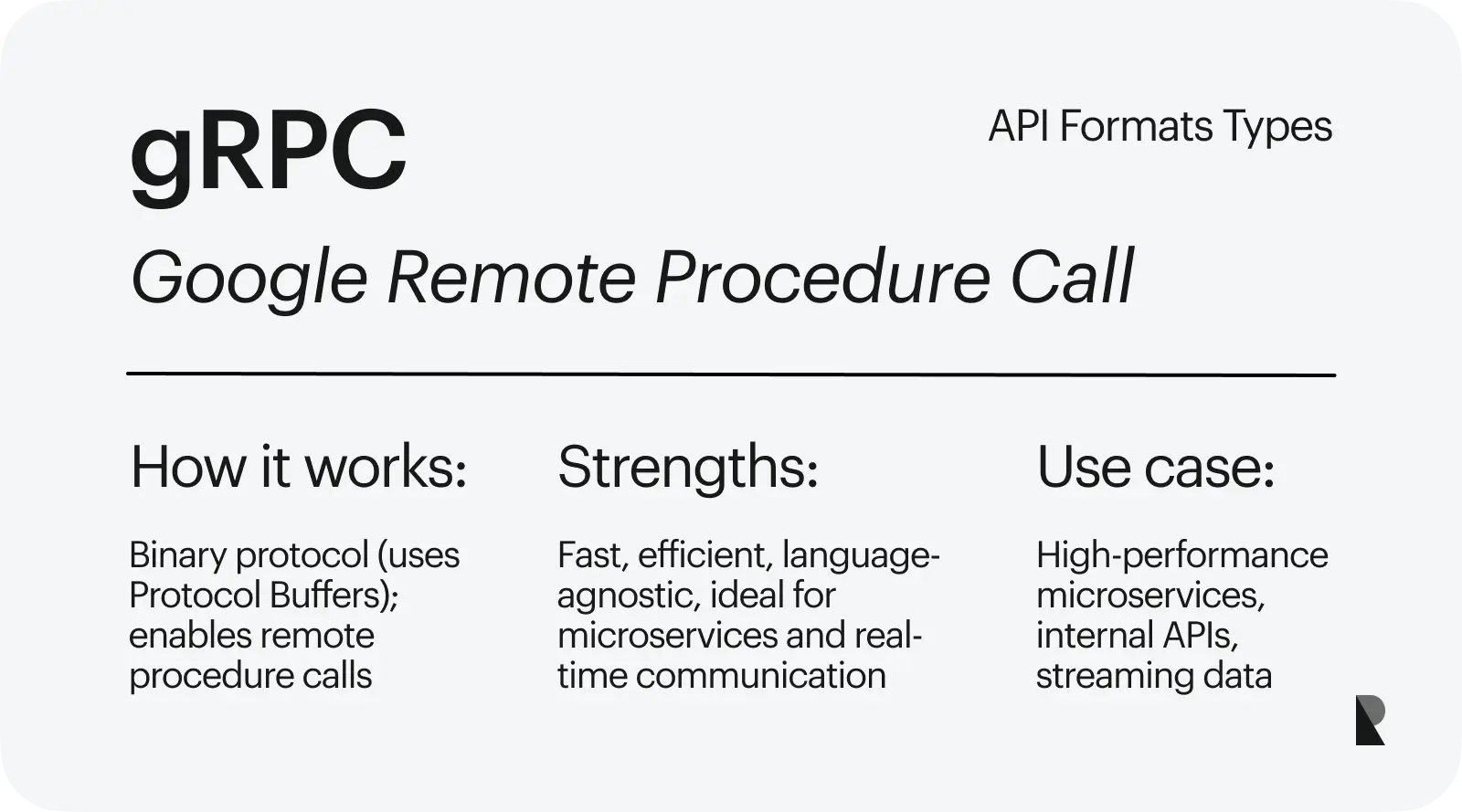
gRPC is an open-source communication framework developed by Google and has been widely used in the industry. It enables remote procedure calls (RPCs) and request/response-based networking for distributed applications. The gRPC API has been designed with performance in mind and runs on a variety of architectures; however, it also aims to offer a better developer experience, allowing devs to focus more on developing exciting new features while less time is spent on programming details.
The four types of web API formats are REST, SOAP, GraphQL, gRPC, and graphql. Each of these formats enables you to transport data at up to ten times the speed of HTTP. Let's take a look at exactly what each type does - and how each stands out from another. Soap API is an open standard for accessing data from web applications and enables communication with remote servers over HTTP. It can be used for both synchronous and asynchronous calls between client and server ensuring that each side has control over separate request-response cycles. SOAP became popular with its wider use in the.NET framework and other platforms.
How do API work?
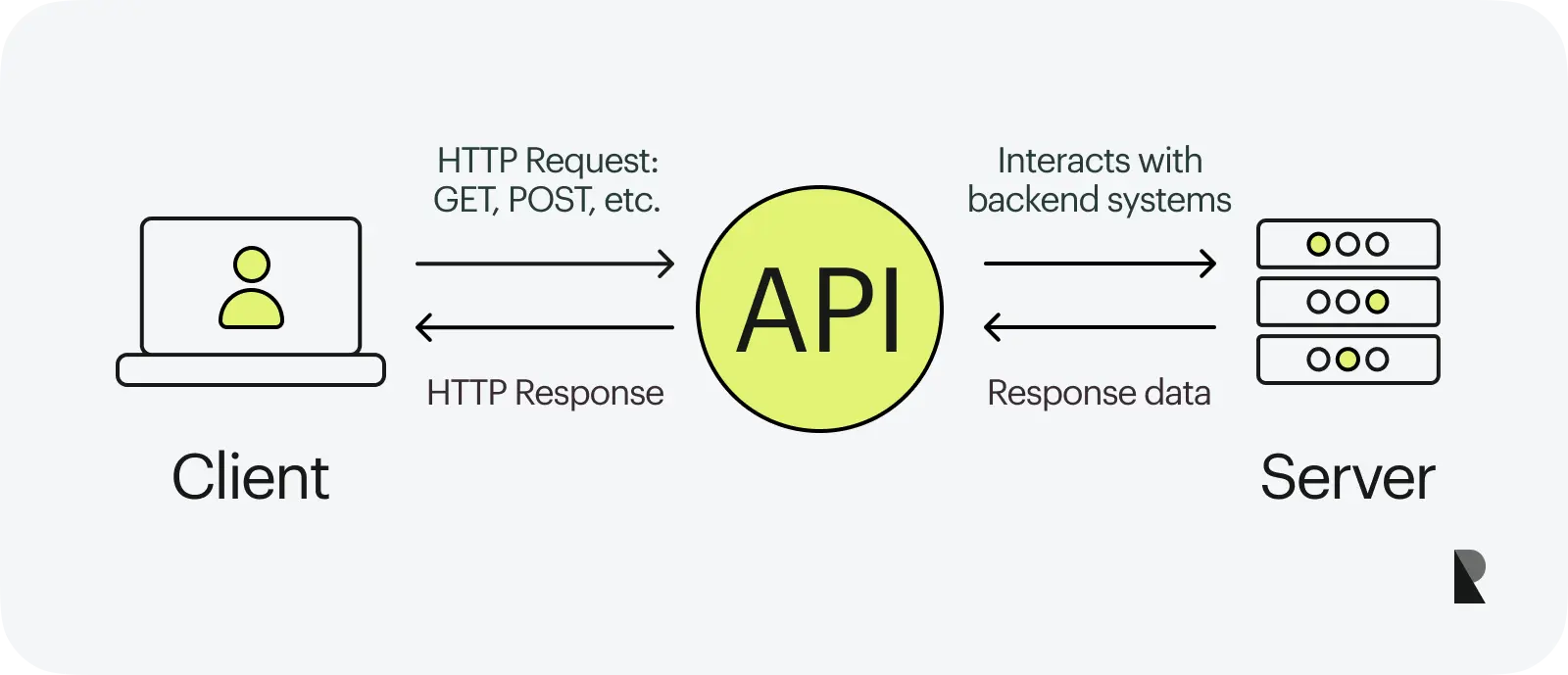
Let's understand how API works with an example of API:
Assume you're going to a restaurant to eat. You don't just go to the kitchen and prepare something and then eat it, do you? (Of course, you are not permitted to do so.) You summon a waiter and place your order. The waiter then goes to the kitchen and gives you your food.
You can compare the API to the waiter here. As a result, API acts as a bridge between two apps, allowing them to connect with one another. In our example, one application represents you, the client, another application represents the restaurant kitchen where the food is cooked, and the waiter represents an API that functions as a mediator between you and the kitchen.
APIs are applications that can be accessed outside of their original application. These APIs allow developers to integrate with the application in a way that allows for data exchange and action execution. Allowing these applications to communicate with each other through their own APIs makes it possible for distributed applications to run on top of different servers or cloud environments.
What is the use of API in a web application?
Assume you have data and wish to publish it so that developers can build software with it. Now you need to figure out how to make this happen. This is where APIs may help. You can create an API to share your data and other resources with developers so that they can use your API to create services or software. Let's take an example: imagine you're developing an app that proposes the vehicle take the route with the least amount of traffic. You will require traffic data from various routes to train a machine learning model and construct your app. Counting the number of vehicles passing on various routes and preparing data is a difficult operation. So what you can do is use a third-party provider that gives APIs for their data.
An API is a set of interface specifications that allows any application on the internet to access, read and write information to a given database which then resides somewhere else. The most common form of this sort of interaction is that between client and web server with both parties using their own software (typically web browsers) in order as tho they were both written by different people or even companies.
Similar to other web technologies, APIs are a key part of the overall software development lifecycle. They provide a way for the developers to access specific functionality from an external source, allowing them to provide a better user experience. APIs are the way of the future. They have already been adopted as a marketing strategy by large corporations, while startups use APIs to develop faster and more efficient apps.
You can use APIs to create a web page that displays information from another source. For example, you can display Twitter feeds or stock prices. If you want to add a feature to your website, then you can integrate APIs to connect to other sites.
Web API Examples
The most powerful APIs are those that allow you to create a unified experience across platforms.
Here are the 10 most popular APIs:
1. YouTube API
YouTube API allows you to integrate YouTube functionality into your web services and web tools. You may search for videos, upload videos, manage playlists and subscribers, change channel settings, and do a variety of other things. All of this without directly accessing the YouTube database or writing any additional code. This is how APIs speed up and simplify development.
Learn more about YouTube APIs here.
2. Twitter API
Twitter API allows you to access Twitter resources and the Twitter platform programmatically. You can connect with Twitter API in the same way you typically would. For example, you can use Twitter API to like, tweet, direct message individuals, attend spaces, access user information, and more.
Learn more about Twitter API here.
3. Open Weather API
Individuals cannot collect weather data from around the world and use it to create anything. It takes a significant amount of time, effort, and money. However, services such as Open Weather are available. Weather forecasts for many places are provided through the Open Weather API. They handle the difficult work of collecting weather data and selling it through their API. As a result, enterprises can simply use this API to create their products.
Learn more about Open Weather API here
4. Imgur API
Imgur's API provides access to the complete Imgur infrastructure through a defined programmatic interface. Using Imgur's API, you can accomplish almost anything you can do on imgur.com while using your preferred programming language. The Imgur API is a RESTful API that accepts HTTP requests and returns JSON responses.
5. NASA API
NASA API allows you access to NASA's data, which is open to the public. You can gain access to near-Earth asteroid data, full disc imaging of the Earth, the NASA Image and Video Library, space sounds, and much more.
6. TMDB API
The Movie Database is a database of movies, web series, and TV shows, among other things. You can get access to that data via their API and use that data to display information about movies, shows, etc in your web application interface.
7. Google Assistant API
Individuals will find it very impossible to create a voice help as advanced as Google Assistant. But you can integrate Google Assistant functionality into your products using the Google Assistant API.
8. Spotify API
Spotify web app API allows users to access user-related data such as playlists and music saved in the Your Music library. Such access is granted by the user through selective permission.
9. Joke API
Joke API is one of the most popular APIs. It gives you access to a database of jokes organized into categories such as programming, dark, pun, and spooky jokes.
10. Google Maps Geocoding API
The act of translating addresses into geographic coordinates, which can then be used to set markers on a map or position the map, is known as geocoding. The Geocoding API can be used to find the address for a given location ID. The Google Maps API allows you to access these services directly using an HTTP request.
Conclusion
An API is a piece of software that allows other software to interact with it. It's akin to the documentation in traditional applications, which you might use to help find things like features and utilities. The benefit you get from using APIs over regular services is making your development process simpler as well as making it easier for others. The OpenAPI Specification is a format for defining the structure and syntax of REST APIs. Making APIs public has various benefits, the most important of which is the ability to freely share data.
The four types of web API formats are REST, SOAP, GraphQL, gRPC, and GraphQL. Each of these formats enables you to transport data at up to ten times the speed of HTTP. APIs are applications that can be accessed outside of their original application. These APIs allow developers to integrate with the application in a way that allows for data exchange and action execution. Allowing these applications to communicate with each other through their own APIs makes it possible for distributed applications to run on top of different servers or cloud environments.
Jul 8, 2022
